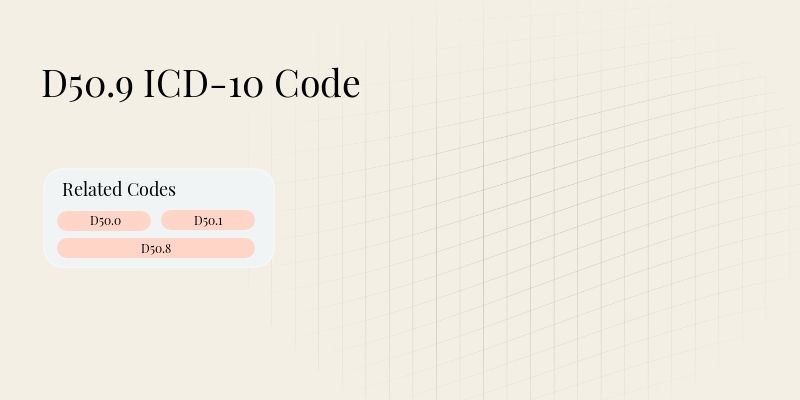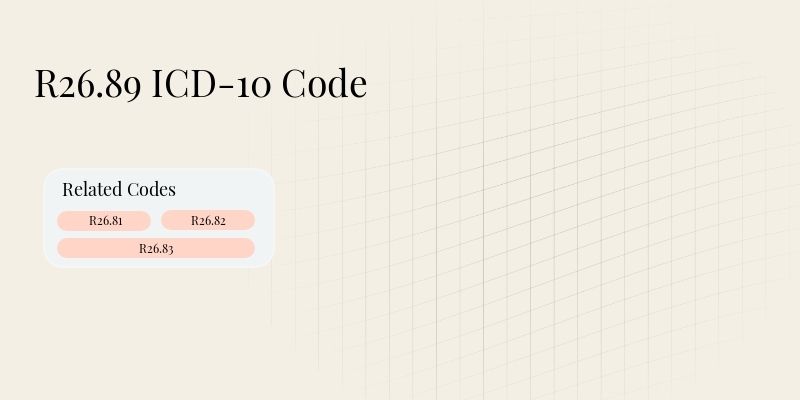
D50.9 ICD-10 Code: Microcytic Anemia

Key Takeaways
- What D50.9 ICD-10 Code Covers: This code specifically identifies microcytic anemia, a condition characterized by smaller than normal red blood cells, often due to iron deficiency. It serves as a crucial tool for healthcare providers in diagnosing and managing this condition.
- Session Duration Requirements: Medical professionals must ensure that the patient’s visit duration aligns with the complexity of symptoms. A thorough evaluation may require longer sessions, especially if additional testing is needed.
- Who Can Use the Code: This code is applicable to a variety of healthcare providers including primary care physicians, hematologists, and specialists in internal medicine who diagnose and manage anemia.
- Best Practice for Proper Use: Accurate documentation is essential. Providers should include specific lab results, patient history, and symptoms to support the use of this code and prevent denials.
- Example of Actual Usage: A primary care physician diagnoses a patient with fatigue and pallor, orders a complete blood count (CBC), and finds microcytic red blood cells. The physician then documents the findings and uses the D50.9 code for billing.
What is D50.9 ICD-10 Code
The D50.9 ICD‑10 code represents microcytic anemia, which is defined as a condition where red blood cells are smaller than normal. This condition is often indicative of iron deficiency and can result in symptoms such as fatigue, weakness, and pale skin. The code is essential for healthcare providers when documenting and billing for this specific type of anemia.
Accurate coding of D50.9 is crucial because it allows for appropriate treatment plans and monitoring of the condition. It also plays a significant role in insurance reimbursements, ensuring that healthcare providers are compensated for their services when managing patients with this diagnosis.
Services Covered Under D50.9 ICD-10 Code
This section outlines the various services that may be covered under the D50.9 ICD‑10 code.
Service | Description |
|---|---|
Complete Blood Count (CBC) | A test used to measure the number of red blood cells, hemoglobin, and other components of the blood, essential for diagnosing anemia. |
Iron Studies | Tests that measure iron levels within the body, including serum iron, ferritin, and total iron-binding capacity, crucial for determining the cause of microcytic anemia. |
Patient Consultation | An appointment where the healthcare provider evaluates the patient's symptoms, medical history, and lab results to formulate a treatment plan. |
Who Can Use the D50.9 ICD-10 Code?
Various healthcare professionals can use the D50.9 code in their practice. Here are some key users:
- Primary Care Physicians: They often first identify symptoms of anemia and initiate treatment.
- Hematologists: Specialists who focus on blood disorders, including various types of anemia, will use this code for specific diagnoses.
- Internal Medicine Specialists: They frequently manage complex cases of anemia and its underlying causes, necessitating the use of this code.
How to Use D50.9 ICD-10 Code
To effectively use the D50.9 code, follow these detailed steps:
- Document Symptoms: Record symptoms such as fatigue or weakness. For example, a patient reports feeling excessively tired and has difficulty performing daily activities.
- Order Relevant Tests: Conduct CBC and iron studies to confirm diagnosis. For instance, if the CBC shows low hemoglobin and microcytic red blood cells, this supports the diagnosis.
- Describe Treatment Plan: Document the management strategy, such as dietary changes or iron supplementation. For example, a physician prescribes iron supplements and advises on dietary modifications.
Reimbursement Rates for D50.9 ICD-10 Code
Insurance Type | Reimbursement Rate |
|---|---|
Medicare | $80.00 |
Private Insurance | $100.00 |
Disclaimer: Reimbursement rates can vary significantly based on numerous factors, including geographical location and specific insurance policies. We strive to keep this article updated with average prices.
Benefits of D50.9 ICD-10 Code
Understanding the benefits of accurately using this code is vital for providers.
Benefit | Explanation |
|---|---|
Improved Patient Care | Using the correct code ensures that patients receive appropriate treatment for their anemia, leading to better health outcomes. |
Accurate Billing | This code facilitates correct billing, ensuring that providers are compensated for their services, preventing revenue loss. |
Data Collection | Accurate coding helps in gathering data for research and public health initiatives aimed at addressing anemia and its prevalence. |
Common Mistakes to Avoid with D50.9 ICD-10 Code
The misuse of the D50.9 code can lead to significant repercussions, such as audits and claim denials. It is essential for healthcare providers to be aware of common pitfalls associated with this code.
- Incorrect Documentation: Failing to document the patient's symptoms thoroughly may lead to code denial. For example, a nurse notes fatigue but does not include additional symptoms like pallor.
- Misinterpretation of Lab Results: Not correlating lab results with the correct diagnosis can cause billing errors. For instance, using D50.9 when the CBC results are normal is a mistake.
- Inadequate Follow-Up: Not scheduling necessary follow-up appointments can lead to incomplete care documentation. For example, a physician fails to document a follow-up after a treatment plan is initiated.
- Using the Code for Non-Specific Anemia: Applying the code for anemia types not classified as microcytic can result in claim denials. For instance, using D50.9 for macrocytic anemia without proper justification is incorrect.
D50.9 ICD-10 Code vs Other Codes
Comparing D50.9 with other related codes is crucial for precise coding practices. Below is a table that highlights differences between D50.9 and similar codes.
Code | Description |
|---|---|
D50.0 | Iron deficiency anemia due to blood loss. |
D50.1 | Iron deficiency anemia due to inadequate dietary iron intake. |
D50.8 | Other specified iron deficiency anemias. |
Conclusion
In summary, the D50.9 ICD‑10 code is essential for accurately diagnosing and managing microcytic anemia. It covers specific conditions, requiring thorough documentation and appropriate billing practices. Various healthcare providers, including primary care physicians and specialists, can effectively use this code to ensure proper patient care and reimbursement. The benefits of using this code extend beyond individual practices, contributing to broader data collection and research efforts concerning anemia. By understanding common pitfalls and comparing it with related codes, medical coding professionals can enhance accuracy, thereby improving patient outcomes and financial performance in healthcare settings.
Disclaimer: This article is for informational purposes only and does not constitute legal or medical advice. Always consult professional guidelines and regulatory bodies for specific compliance requirements.
Frequently Asked Questions
Reduce burnout,
improve patient care.
Join thousands of clinicians already using AI to become more efficient.

90833 CPT Code: Therapy add-on
Discover essential insights on the 90833 CPT Code code for health professionals. Enhance your practice and navigate billing with confidence.

R26.89 ICD-10 Code: Ambulatory Dysfunction
Discover essential insights on the R26.89 ICD-10 Code code for health professionals. Enhance your practice and navigate billing with confidence.

PR-242 Denial Code: Services Not Provided By Providers
Discover essential insights on the PR-242 Denial Code code for health professionals. Enhance your practice and navigate billing with confidence.
